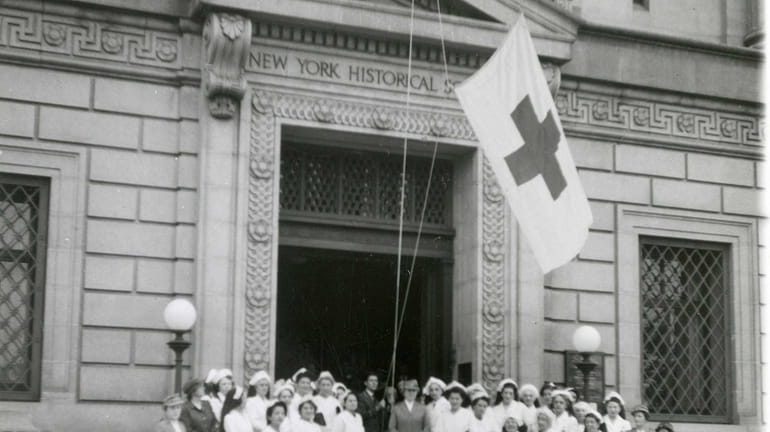WWII & NYC exhibit includes LI contribution

Beginning in June 1942, at the invitation of the board, the New-York Historical Society's two large first-floor exhibition galleries were converted into surgical dressing stations by the American Red Cross. (Sept. 21, 2012) Credit: New-York Historical Society
Soldiers and sailors swarmed New York City. Hundreds of merchant ships transporting supplies for the fight in Europe crowded New York Harbor. The bright lights of the big city were dimmed so they would not silhouette vessels offshore being hunted by German U-boats.
From 1941 to 1945, the signs of wartime were nearly everywhere in New York and the surrounding area, including Long Island, as a new exhibit at the New-York Historical Society displays through more than 300 objects, maps and firsthand accounts.
"We thought we knew the war, but none of us really were prepared for the size of the role that New York played," said Marci Reaven, curator of WWII & NYC, which opens Friday at the museum at Central Park West and West 77th Street in Manhattan.
The 3,000-square foot exhibition will show how New Yorkers mobilized. More than 900,000 New Yorkers -- more than one-tenth of the population -- served in the armed forces, and many more contributed to the war effort. Women filled factory jobs that harnessed America's industrial strength to the cause of victory. Food and gasoline and other consumer items were rationed.
Artifacts on display include a vial of penicillin made in Brooklyn by Pfizer, which produced 90 percent of the antibiotic for the military, and a Nazi armband worn by a Bronx librarian who infiltrated an Axis sympathizers' gathering in Manhattan for police.
The most unusual item is part of a cyclotron, or atom smasher, used by physicists at Columbia University to test nuclear fission. The work was the foundation for the Manhattan Project that built the atomic bombs dropped on Japan, ending the war. The rarely seen device is on loan from the Smithsonian in Washington.
New York Harbor was a central part of the war story, and is a main focus of the exhibit.
In 1941, it was the busiest port in the world as the United States supplied war materials to the Allies. Photos show more than 100 merchant ships passing through the area as they journeyed across the treacherous Atlantic in convoys stalked by German subs.
After America entered the war, more than 3 million soldiers trained, partied and said goodbye to their homeland in New York City before boarding ships for battle in Europe and beyond.
"The city looked like it does during Fleet Week but it was all the time," said Kenneth Jackson, chief historian of the exhibit and former president of the New-York Historical Society.
A painting by Irving Boyer, "Prospect Park," shows carefree soldiers and sailors on a train platform. The grim illustration "Embarkation -- Prelude to Death," by Thomas Hart Benton shows young men hauling gear as they board a troop ship to fight in North Africa.
New Yorkers feared their city would be a target, like London and Warsaw. Thousands signed up for civil defense. "Target No. 1: NYC, Protect it Now and Enroll," said a recruitment poster.
Lights were dimmed or blacked out at night. The exhibit displays a three-foot-high air raid siren from Brooklyn and a lightbulb partly painted over to only shine downward.
The city was spared attack. But a photo of the British tanker Coimbra, torpedoed by German U-boat less than 30 miles off the Hamptons, serves as a reminder that the war wasn't always far away. Bodies from attacks on shipping sometimes washed ashore on Long Island, Reaven said.
There are also pictures of the military tribunal of four German spies and would-be saboteurs who landed on Amagansett in 1942 via a U-boat with four crates of explosives. All were caught or surrendered. "It was an inept operation but alarming at the time," Reaven said.
Long Island's contribution to war production is noted, particularly the manufacture of fighter planes. The exhibit has a model of a Hellcat, made by Grumman Aircraft Engineering Corp. in Bethpage to battle with Japanese fighters, and a discussion of the lengths the company took to attract female workers during wartime, such as providing day care.
There is a profile of Brig. Gen. George Jones, 89, of Roosevelt, who talks on tape about his time serving in the "Red Ball Express" truck convoy unit. He was assigned to the mostly black unit, which brought supplies to the Allies as they advanced toward Berlin, because the Army's segregation policy prevented him from serving in a combat group.
Still, Jones recalls, "You got shot at, you got bombed. We were in combat, pure and simple."
When the war ended, some of the most unforgettable images of V-J Day were the celebrations in Times Square. The exhibit includes the photo of the iconic kiss between a sailor and a nurse.
